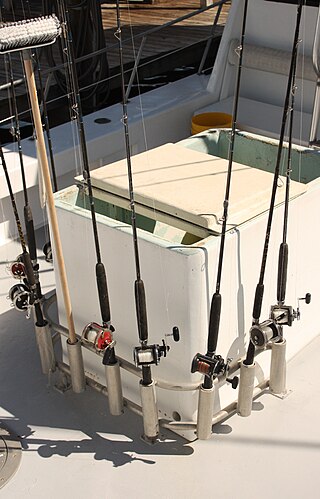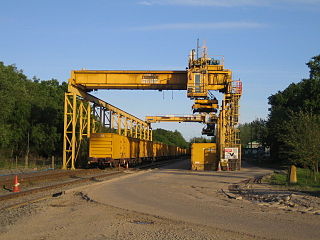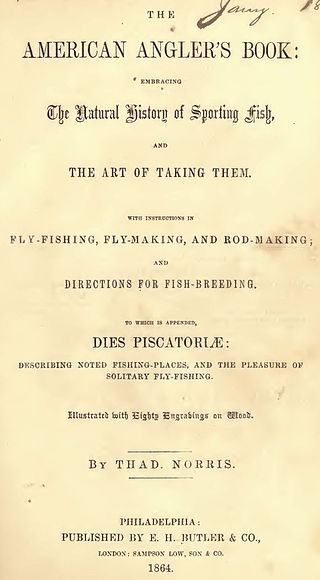
A fishing rod is a long, thin rod used by anglers to catch fish by manipulating a line ending in a hook. At its most basic form, a fishing rod is a straight rigid stick/pole with a line attached to one end ; however, modern rods are usually elastic and generally have the line stored in a reel mounted at the rod handle, which is hand-cranked and controls the line retrieval, as well as numerous line-restricting rings that distribute bending stress along the rod and help dampening down/prevent line whipping and entanglement. To better entice fish, baits or lures are dressed onto the one or more hooks attached to the line, and a bite indicator is used, some of which might be incorporated as part of the rod itself.
Deerfield Township is a township in Cass County, Minnesota, United States. The population was 154 as of the 2000 census. Deerfield Township was named for the large population of deer within its borders.

Angling is a fishing technique that uses a fish hook attached to a fishing line to tether individual fish in the mouth. The fishing line is usually manipulated via a fishing rod, although rodless techniques such as handlining also exist. Modern angling rods are usually fitted with a fishing reel that functions as a cranking device for storing, retrieving and releasing out the line, although Tenkara fishing and traditional cane pole fishing are two rod-angling methods that do not use any reel. The fish hook itself can be additionally weighted with a denser tackle called a sinker, and is typically dressed with an appetizing bait to attract and entice the fish into swallowing the hook, but sometimes an inedible fake/imitation bait with multiple attached hooks is used instead of a single hook with edible bait. Some type of bite indicator, such as a float, a bell or a quiver tip, is often used to relay underwater status of the hook to the surface and alert the angler of a fish's presence.

Lough Derg or Loch Derg is a lake in County Donegal, Republic of Ireland. It is near the border with Northern Ireland and lies about 7 kilometres (4.3 mi) north of the border village of Pettigo. It is best known for St Patrick's Purgatory, a site of pilgrimage on Station Island in the lake.

Calvert is a village in Buckinghamshire, England, near the village of Steeple Claydon.

Recreational fishing, also called sport fishing or game fishing, is fishing for leisure, exercise or competition. It can be contrasted with commercial fishing, which is professional fishing for profit; or subsistence fishing, which is fishing for survival and livelihood.

The River Ivel is a north-flowing river in the western part of east of England. It is primarily in Bedfordshire; it is a tributary of the River Great Ouse and has sources including in the Barton Hills.

Arlesey is a town and civil parish in the Central Bedfordshire district of Bedfordshire, England. It is near the border with Hertfordshire, about three miles north-west of Letchworth Garden City, four miles north of Hitchin and six miles south of Biggleswade. Arlesey railway station provides services to London, Stevenage and Peterborough. The Domesday Book of 1086 mentions Arlesey. The town's name means the 'island of a man named Aelfric'.

Richard Stuart Walker was an English angler.

Coarse fishing is a phrase commonly used in Britain and Ireland. It refers to the angling for rough fish, which are fish species considered undesirable as food or game fish. Freshwater game fish are all salmonids, particularly salmon, trout and char. Generally, coarse fish are freshwater fish that are not salmonids, though there is often disagreement over whether grayling should be classified as a game fish or a coarse fish.

Spin fishing is an angling technique where a spinnerbait, a type of hybrid fishing lure with at least one freely rotating blade, is used to entice the fish to bite. When the line is reeled back, the spinnerbait blades will spin passively with oncoming the water flow, in turn stirring up significant amount of turbulence and noise, which transmit through the water and provoke predatory fish to strike the lure out of their foraging as well as territorial instincts. Spin fishing is used in both freshwater and marine environments.
Lough Island Reavy is a small man-made lough in Kilcoo, County Down, Northern Ireland. It is a fishing spot, which is controlled by the Kilcoo Angling Club. The lake contains pike and perch, as well as small numbers of wild brown trout and eels.
This page is a list of fishing topics.
The following outline is provided as an overview of and topical guide to fishing:
The Sabattus River is an 11.4-mile-long (18.3 km) tributary of the Androscoggin River in Maine. It rises at the outlet of Sabattus Pond in the town of Sabattus and flows south into the town of Lisbon, reaching the Androscoggin just southeast of Lisbon Center and about 1.5 miles (2.4 km) upstream (northwest) of Lisbon Falls. Via the Androscoggin River, water from the Sabattus River flows to the Kennebec River at Merrymeeting Bay and ultimately to the Atlantic Ocean.

This is an impartial and comprehensive record list of 305 British record freshwater fish, past and present, involving 60 different species/sub-species of fish caught using the traditional angling method of rod and line. Records to include the angler, species, weight, date, venue, also referenced with a recognizable publication. The list is intended to include all categories of fish caught by anglers, that enter freshwater including and some migratory sea fish. The time since last record fish was caught is 206 days.

The American Angler's BookEmbracing the Natural History of Sporting Fish and the Art of Taking Them with Instructions in Fly-Fishing, Fly-Making, and Rod-Making and Directions for Fish-Breeding, to which is appended Dies Piscatoriae Describing Noted Fishing-Places, and The Pleasure of Solitary Fly-Fishing is an early American angling book by Thaddeus Norris (1811-1877) first published in 1864. Norris was known as Uncle Thad and commonly referred to in American angling history as "The American Walton".
Paices Wood Country Parkland is a country park on the edge of the village of Aldermaston in Berkshire, England. The parkland is under the management of the Berkshire, Buckinghamshire and Oxfordshire Wildlife Trust.













